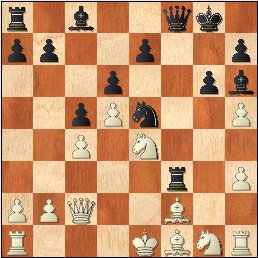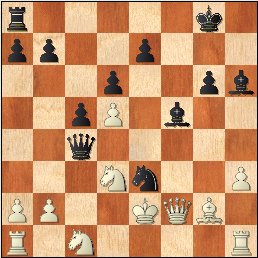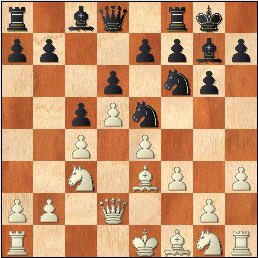Is this Nunn's greatest game? |
An explanation of the symbols that I commonly use, when annotating a chess game. ---> Replay this game ... on another server.
GM A. Beliavsky (2635) - GM J. Nunn (2615)
|
|
|
One of the more brilliant games of
all time, certainly one of the best of the 20th Century ...
and {also} perhaps GM John Nunn's best game.
*******************************************************************************************************
1.d4 Nf6;
2.c4 g6; 3.Nc3 Bg7;
A King's Indian Defense.
Volatile, dangerous - to both parties!
---> And incredible brilliancies ... from both sides of the board.
4.e4 d6;
5.f3!?, {Diagram?}
The Samisch Variation, White builds a big pawn front, that can be used for both offense or defense.
One of the main ideas of the Samisch is to be able to attack Black, castle on the Q-side, and then pry
open the h-file. [
For a brief lesson in this opening, see my January, 2005
... lesson/column ...
on "The World Chess
Academy." ]
[ Standard is: 5.Nf3, "+/=" with good play for White. [more, more] ]
5...0-0;
6.Be3 Nbd7!?;
Praised by some annotators, and condemned by others; to me, it appears slightly passive, (as it blocks in the QB); but also fully playable. (See any good book on this particular opening.)
[ For the move:
(>/=) 6...Nc6;
"~" {D?}
see MCO-14, page # 601;
columns # 43 and also col. # 44; and all applicable notes.
]
7.Qd2,
('!?')
Easily - both logical and playable. (And also part and parcel of this whole opening system.)
[ According to theory (today), it is better for White to play:
(>/=) 7.Nh3!? c6; 8.Qd2 e5;
9.d5 cxd5; 10.cxd5 a6; 11.Nf2 Nh5; 12.Nd3!?,
"+/="
with a slight plus for White.
Ibragimov - Mittelman; ICT, Biel (BTO) Open / 1997.
[ See MCO-14, page # 601; columns 43 - 48, and all notes. Especially note # (s.). ] ]
7...c5!?;
(Probably - '!')
Many "KID" players like to play ...e7-e5; here this move is probably to be preferred, as the Bishop on g7 will not be shut in.
8.d5 Ne5!;
(TN)
The sharpest move for Black ... it was also brand-new to theory when this game was played.
[ Previously, the move of:
8...a6!?;
"~" was usually played in this position.
(An older line, this position was first reached in tournaments ... was back in the 1930's!!)
See the master contest:
M. Dlugy - E.
Meyer; ICT / The World Open, (CCA); Philadelphia, PA/USA; 1987.
{I personally witnessed this fight, it was drawn in 36 total moves.}
]
9.h3!?,
(hmmm) (Maybe dubious?)
{See
the diagram given, just below.}
This move, which was condemned by many, ('?'); is actually logical ...
and is the first choice of several strong computer programs. (White plans to play f4, it appears that Black will be ruthlessly pushed back.)
**********************************
|
|
**********************************
r1bq1rk1/pp2ppbp/3p1np1/2pPn3/2P1P3/2N1BP1P/PP1Q2P1/R3KBNR
(Black)
The loss of time here (for White) is pretty obvious. Yet, it is not at all clear how Black will go about defusing White's extremely ambitious and aggressive idea. (Beliavsky attempts to refute Nunn's whole plan that begins with 8...Ne5.)
[ (>/=) 9.Bg5!?, - GM Jan Timman ]
9...Nh5!;
Black targets the weakened dark squares on the King-side, especially g3. (Some {beginner} students thought that this looked both like a loss of time for Black, and somewhat risky.)
[ </= 9...Bd7?!; 10.f4!, '±' ("+/-") ]
10.Bf2!?,
(hmmm)
Seemingly the most natural move, ("Probably best," says the authors of the 'Mammoth Book.');
and the first choice of several good computer programs. White's original intention ...
simply does not work here.
(10.f4, Ng3; "/+" )
However, this move was condemned by many, and it was labeled as dubious ('?!') by the annotator
in the Informant, (Vol. # 39.). Yet this strikes me as far too reactionary.
[ Not </= 10.Nge2?? Nxc4; "/+" etc.
********************************************
Interesting was the continuation of:
(>/=) 10.Qf2!? Qa5!;
"~" {Diag?}
when Black has a ton of play.
("=/+") ]
10...f5!;
(thematic)
As in most KID
systems, this pawn break is crucial to Black's overall aim of achieving counterplay.
(Some books considered this idea slightly risky in this pawn structure, especially prior to this game.)
Now White exchanges, lest the second player gets in ...f5-f4.
11.exf5!? Rxf5!!; ('!!!')
Super-brilliant! (It LOOKS like a simple blunder ... and that Black has just walked into a Pawn fork, and this is a point that dozens of folks have queried me about.)
Even today, (2005); most programs will evaluate the resulting positions as being won ("+/-") for White.
[ Instead, the box prefers to play:
</= 11...gxf5!?;
12.g4 Nf6; "~" {D?}
when Black has a playable game ... but nothing more.
(- Fritz 8.0, CE)
]
Now White grabs the bull by the horns, and accepts the challenge.
(If Beliavsky doesn't play g4, then Black simply plays ...Nf4; and also ...Bh6; with a very good game.)
12.g4 Rxf3!;
The best - and not at all simple.
(Most of my students choose - the seemingly better and more obvious - move,
12...Nxf3+;
in this position for Black.)
13.gxh5 Qf8!;
"--->" {Diagram?}
Putting great pressure down the f-file ... without delay. (Maybe
- '!!')
(In 2001, most programs choose 13...Bf5; in this position for Black.)
14.Ne4,
('!')
Given an exclam by Nunn - who goes on to show how several of White's other tries can lose ...
some of the analysis was the result of 'home-cooking' and also very unusual, creative and very brilliant.
[ Maybe
(>/=)
14.Rh2!?,
"+/=" (Fritz)
****************************************************************************************
After the seemingly simple moves:
14...Bh6!;
('comp')
[
Or "="
14...Qf5!?; 15.Qe2 Nd3+; 16.Qxd3 Rxd3;
17.Bxd3 Qxh5; "=/+" ]
15.Qc2!?,
('?' - GM J. Nunn)
{See
the diagram given, just below.}
**********************************
**********************************
This is a good place for a diagram ... to see if you can guess what the good Doctor will do next.
[ The best continuation is: 15...Qf4!!;
(Wow!)
John Nunn only awards this move one exclam ... but that is way too modest, at least - in my opinion.
16.Ne2 Rxf2!;
17.Nxf2, ('[]')
[ But not:
</=
17.Nxf4?? Rxc2;
"-/+" ] 17...Nf3+;
18.Kd1[] Qh4!; '!' - GM Alexander Beliavsky
(Informant, Volume # 40.)
[ Not
</= 18...Qe3!?; ('?!')
as 19.Ng4!,
'±' is simply (much) better for White.
White's next play looks to be virtually forced for Beliavsky here. (Nc3?, Nd4) 20.Nec1?!,
(ouch)
[ White should have played: 20...Nd2!;
20...Nd2!; ('!!' - GM Nigel Short.)
GM
N. Short, when he annotates
this game for the Sunday edition of the English newspaper, (The
London Telegraph); awards John Nunn's 20th move ... a
DOUBLE-exclam!
[
</=
20...Nd4;
('!?') 21.Qf2,
"~" ]
The rest actually requires no comment, but ... (sometimes, I just can't help myself!).
[ Even worse would be:
**********************************************************************************
Also bad for White is:
</= 22.Qxd2?! Bxd2; 23.Kxd2 Qxc4;
{D?} 22...Nxc4; 23.Qf2,
{Box?}
[ No better was:
</= 23.Re1?! Bxc1!;
"-/+" winning easily.
Note that Black could favorably regain the piece by exchanging on f2, and then forking on
e3. However, Nunn continues to find the lines that apply the maximum amount of pressure.
**********************************
********************************** This is an interesting position. White is way ahead in material ... but is unable to defend the most
important piece here!
[
</= 24...Qd4!?;
25.Rd1 c4; "-/+" ] 25.Bf3 Rf8;
26.Rg1 Nc2;
27.Kd1,
[ Or
("=") 27.Kf1!? Be3; "-/+"
] 27...Bxd3;
("-/+") {Diagram?}
This magnificent struggle was:
Without question, one of the finest and most beautiful, deep and exquisite combinations of the last half of the 20th Century.
****************************************************************************************************************************
This game can already be found in literally dozens of chess books - nearly every book, (especially tomes on the KID opening); printed since 1985 has touched upon this great struggle.
(I also saw this game in a few newspaper columns
and magazines ... mostly right after it was played.)
Probably the most helpful to my cause were the following:
"Secrets
of Grandmaster Play," by GM J. Nunn and P.
Griffiths. (1987) ISBN: # 0-02-053130-3 The
INFORMANT, Volume # 39. (Game #
734.) "Chess
Brilliancy," ('250 historic games from the
masters'); by NM Iakov Damsky. <The Mammoth Book Of>
"The World's Greatest Chess Games,"
by Dr. J. Nunn, GM John Emms,
(Plus - several books on chess tactics and the King's Indian Defense.)
Copyright (c) A.J. Goldsby, 2005.
All rights reserved. The
game and the analysis were prepared with the program, ChessBase
9.0. The program, MS FrontPage
was used to polish and prepare the analysis for my website. (The
diagrams
were also made with CB 9.)
should be investigated? (This move has been {mostly}
ignored by most of the 'experts' who have deeply analyzed this game.)
</= 14.Rd1!? Bf5!; 15.hxg6 Bxg6;
16.h4 Bh6!;
"~" "/\"
{D?}
and White suddenly finds himself in a lot of hot water.
(The WQ has difficulty in finding a safe square.)
]
The most energetic move ... according to several sources.
Seemingly the most natural move ... but it may lead to a forced loss. Yet it is also one of the grandest and most beautiful combinations of the whole of the twentieth century. (So I find it difficult to be too harsh on GM Alexander Beliavsky here.)

r1b2qk1/pp2p2p/3p2pb/2pPn2P/2P1N3/5r1P/PPQ2B2/R3KBNR
(Black)
>/= 15.Qe2! Nd3+; 16.Qxd3 Rxd3;
17.Bxd3, "+/=" 17...Qf4!;
"<=>" - GM J. Nunn
(The author - in the excellent volume -
"Secrets of Grandmaster Play," investigates
the resulting positions VERY deeply. Please see that book, if you are curious about
the results of his work.)
]
Black does not retreat ... but offers more material to keep the fires of his initiative from dimming.
This appears to be forced.
Black has White in a bind ... (but) can it really be worth a whole Rook?
(Maybe just "+/-")
]
19.Nd3 Bf5;
('!')
A simple developing move ... that is also a devastating pin.
Seemingly forced ... this is the move that is an error ...
and finally allows Black to smash down the walls of White's well-constructed defense.
>/= 20.Qc3! Bg7!?; 21.Qb3 Bxd3;
22.Qxd3 Qe1+;
23.Kc2 Qxa1; 24.Qxf3 Qxb2+;
25.Kd1, "~"
("+/=")
[ See the "Mammoth Book"
... (by Nunn, Emms, & Burgess);
for a very detailed analysis of these lines and
positions. ] ]
This amazing Knight move, leaping into the heart of White's position, ties the first player ... (up) in knots.
21.hxg6 hxg6;
22.Bg2,
White was in a bad way, maybe Qc3 was the best defense here for A.B.
</= 22.b3? Qe4;
23.Rg1 Qe3!; "-/+"
when Black is winning.
with
the idea of:...Qxd5,
and then ...c4.
("-/+") ]
Now the threat to fork on the e3-square is just too strong.
There is nothing better here.
(Black can also try: 23...Qh5+!?;
as given in Informant # 39.) ]
23...Ne3+!;
24.Ke2 Qc4!; ("-/+") {See
the diagram given, just below.}
This play is given an exclam by almost all the annotators ...
although Black could win (simply) with other means, he does not let up. Not only this, this move signals a switch in the arena of play. (Beliavsky has actually managed to defend his K-side, but now is
unable to cover certain squares on the opposite side of the board. The threat is now to play
25...Bxd3+; 25.Nxd3, Qc2+; winning back material, with interest!)

r5k1/pp2p3/3p2pb/2pP1b2/2q5/3Nn2P/PP2KQB1/R1N4R
(White)
The choice here is ... death by hanging, or death by poison. (There is
no
escape for White.)
"Big Al" has had enough ... and gracefully tosses in his hat. (White
Resigns, 0-1.)
# 1.) The Brilliancy Prize winner.
# 2.) One of the best of the year.
# 3.) Voted as the best game of the Informant, Volume # 39.
(It is - also - one of the all-time great KID games, IMOHO.)
BIBLIOGRAPHY:
(Copyright 2002, Everyman Chess.) ISBN: # 1-85744-1-274-1
and also FM G. Burgess. (Updated Edition.) Copyright (c) 2004, by the authors. Published by Carroll and Graf. (NY)
ISBN: # 0-7867-1411-5
(I have annotated this game many times before, this time it was done
with two main ideas:
Keep it as short as possible, yet touch on the most important
ideas and variations.)
0 - 1
Go ...
or return ... to my Home Page for this site.
Go (or return) ... to my "Annotated
Games" (II) Page.
Go ... or return ... to my "Best
Games" Page. (You could also use the "back" button on your web
browser.)
*******
Copyright
(c) LM A.J.
Goldsby I
Copyright © A.J. Goldsby,
2015. All
rights reserved.
*******
I first annotated this game ... with the intention of posting the results on my web site ... over 10 years ago.
This page was first posted on: Saturday; September 10th, 2005. This game was last edited, altered or saved on: 04/25/2015 .
